We’d like to thank Shilpi and Amit Mehta for hosting the potluck dinner last night. My talk was on “Common Pitfalls of Paleo,” and it was a pleasure to meet so many Paleo enthusiasts, including people we knew from PaleoHacks, email, comments, and Facebook.
We brought pumpkin soup to the potluck, and that will be our food post this week. But we’ve had some questions about bone broths, so let’s revisit that first.
Making a Tasty Broth
Earlier, we discussed making a broth from ox feet (Ox Feet Broth, Miso Soup, and Other Soups, Jan 2, 2011). The advantage of feet (ox feet, chicken feet) or tails (ox tail) is that they have a lot of connective tissue, so they make a gelatinous broth full of nourishing collagen.
However, you can make a good broth from any bones, and it’s possible to find marrow bones that also have some connective tissue. With longer cooking, you can extract collagen and minerals from the bone itself, and get a good broth from these larger bones.
We’ve found, on limited data so far, that bones from grass-fed animals from local farms seem to produce a tastier broth than supermarket bones. I’d be curious to hear if others have had the same experience.
A few other tricks can help make a tasty broth. One tactic that seems to work is to discard and replace the cooking water at an early stage.
Here’s what we do. In this case, we started with a mix of beef and pork bones:
As you can see some blood comes out of the bones, especially the pork bones, almost immediately. This may be responsible for the poor taste some experience.
We put the heat on very low and let the water warm up gradually. Before it reaches a boil, after an hour or less, it looks like this:
At this point we drain and discard the liquid, adding new water. It now looks like:
You can see the marrow inside the pork bones, which will fall out before we’re done, and the ligaments and tendons in the joints, which will produce a nourishing gelatin. Bits of meat and fat will also be released.
After some hours of cooking, all the meat and fat and most of the marrow and connective tissue will have fallen off the bones. It will look something like this:
At this point you can pour out the broth into a container and use this fatty, meaty broth for rich soups. Seaweed, vegetables like tomatoes and onions, and thinly sliced beef, tendon, or pork bellies go well with this broth. We often use it for Pho (Vietnamese Noodle Soup) (Feb 27, 2011).
Add water and acid and continue cooking. This second round of broth will mainly contain minerals and some collagen, and will need longer cooking.
In the second and later rounds of cooking, we add an acid to help extract minerals from the bones and expose the collagen matrix. Lime juice, lemon juice, and vinegar all work well. We especially like the juice of a lime, and rice vinegar, which gives a slightly sweet taste; others seem to like apple cider vinegar, which is more acidic.
Here are our beef and pork bones early in the process:
And here they are later:
The bones will be obviously softening by this point, as you can tell by poking them with the tine of a fork.
If you wish, you can once again collect the broth, add new water and cook again. Every successive broth will be lighter. In the third round, with long enough cooking, the broth becomes white, like this:
I have heard that in earlier times, when food was costly but fuel cheap, that bones would get cooked until all the nutrients had been extracted – for as long as a month.
Pumpkin Soup
Pumpkins are abundant in New England in October, and we love pumpkin soup.
Here are the ingredients – garlic, onion, and pumpkin:
On very low heat, gently cook the garlic and onion in 3 tbsp butter:
Then add the diced pumpkin and enough bone broth to cover:
Bring to a simmer but don’t boil. When the pumpkin is cooked, after about 20 minutes, use a hand blender to puree the pumpkin-onion-broth mixture in the pot. It will look like this:
Add salt, pepper, cinnamon, and nutmeg to taste, and 1 tbsp rice syrup for a touch of sweetness. Add curry, or other spices, if you like a more flavorful soup. Serve hot, adding a dollop of sour cream if you like a richer, fattier taste:
A delicious autumn appetizer! It can even serve as a meal by adding meat and vegetables to the soup.







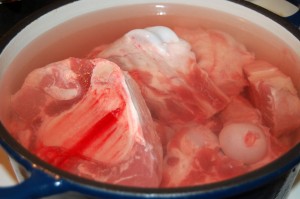
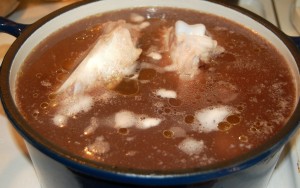
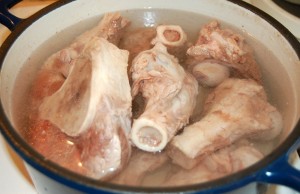

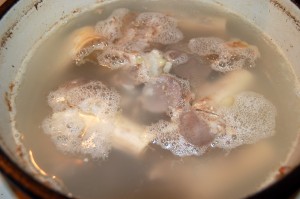
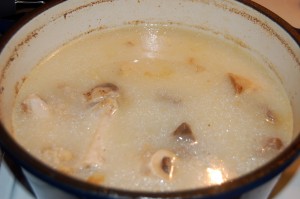
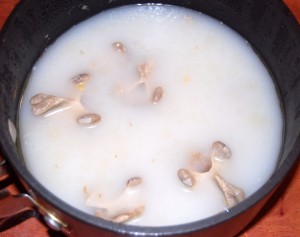
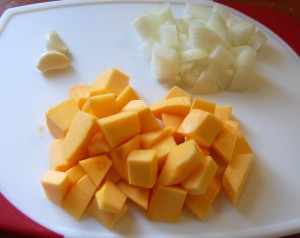
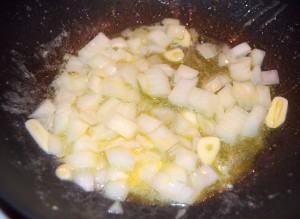
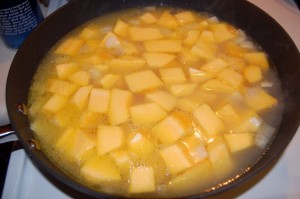
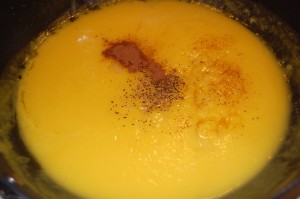
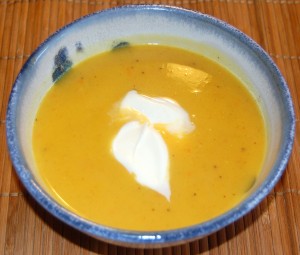




Hi KH,
We’ve never had a fractured bone so I’m not sure if the discoloration you’ve seen is what usually happens in that case. It might also matter when the fracture happened and whether it was contaminated in some way. It would be nice to have bones from healthy cows that weren’t damaged and were kept continuously frozen after the slaughter.
Shou-Ching thinks there’s no need to roast the bones first. Cover the bones in water, apply low heat, the water will become red with blood and then turn brown around the 1-2 hr mark as the water approaches a boil, then discard the water and add new water. You’ll notice the discarded water will smell poorly. After that everything should taste great.
You decide whether the fractured bone is worth eating or not. Who knows its history. Do you have a Whole Foods near you? They will sell bones including grassfed bones.
Best, Paul
so the discarding after 1 hour gets rid of all the uric acids, foul matter, purines etc? if this is so, then my big reservation about broth can be put to rest! i know the indians and mongols squeeze the meat so no juice remains, as it contains all the toxic substances.
is this the authentic way of stock cooking in asia?
thx a lot,
viktor
Hi Viktor,
I don’t know if it’s traditional/authentic but we’ve found it greatly improves flavor. Shou-Ching figured this out on her own, after realizing that newly purchased bones sometimes smelled like old blood. So if traditional peoples did it, Shou-Ching invented it independently.
it makes a lot of sense to me, washing out all the inevitable garbage substances first, then slowcooking for days. obviously that must also improve flavor in the process.
thanks for the simple and great idea.
Just a quick report… I decided to throw out the whole pot. I hate to waste and I agonized over what to do, but I couldn’t stop thinking about the possibilities of that fractured bone. So realizing that I wouldnt be able to eat it in peace, I had to throw it away.
I did find a local butcher though who has grass-fed beef bones and he told me they are definitely white not gray! This is good! 🙂
Thanks again! Can’t wait for the cookbook whenever you guys finish it.
KH
i’m wondering about making broth from bones leftover from cooking-such as beef shanks. it seems a shame to just throw those out, but i’m not sure if the minerals are already cooked out of the bones?
Hi Susan.
I keep all my leftover bones from roasting: lamb, beef, veal and chicken and freeze. Then when I have enough I usually mix some fresh bones (or meat) with leftover bones from the freezer. These are great not only to make broths, but I make glaces with them. Also with fish stock. I reduce a full flavoured stock to a 1/4 or more, depending on what I want to cook. Glazes can give you a beatiful sauce in a flash. Even a vegetable as a side get a very nice treatment with a few cubes of veal glaze.
Hi Susan,
It takes a while to cook the minerals out. Try putting them in water with some salt and acid, and see what the broth is like.
I just tried making broth for the first time, and well, let’s just say I have a long way to go. The first batch came out very meaty and rich, almost stew-like (I bought “soup bones” from a farmer’s market that were very meaty). I then added about a tablespoon, maybe more, of apple cider vinegar to the bare bones with maybe 3/4 gallon of water. After 40 hours of simmering in the slow cooker, the “broth” remains almost clear, not hint of whiteness or yellowness like in your pics. The bones seem to be very firm still. And I can’t say I care for the smell. I don’t know what I did wrong. Maybe not enough vinegar? Ah well, practice makes perfect. Maybe I will use different bones next time. I hope I get it right because I know Paul emphasizes the benefits of broth.
Hi Thomas,
Do you have an idea what temperature the slow cooker got the broth to? We do fine simmering on the stove for 3 hours.
How does the broth taste? You’ll get a clear broth if there was not much joint tissue or available collagen.
Not sure what may have caused the smell. Did you remove any marrow from the bones at the end of the first batch?
I guess I’d advise experimentation. Let your taste guide you; if it tastes good, it’s good for you.
No idea what the exact temp was, but the broth was simmering (it was on the “low” setting). The taste is hard to describe, it wasn’t unpleasant, but the best I can describe is “musty” or “earthy.” I think the problem might have been the bones themselves. I didn’t see any marrow in them when I purchased them, unlike bones I’ve seen at the grocery store. And no marrow appeared in the broth in the first or second batch. The bones were frozen in June 2011, FWIW. I don’t know if there is a use-by date for bones to be used for broths. I’ll keep experimenting! The broth you and Shou-Ching make looks delicious, so I am sure it is something I am doing wrong or the bones I am using.
I would agree, it may have been the bones were moldy or dirty.
Hi Paul,
What kind of pot do you recommend using for the bone broth? Do you not like stainless steel?
I have been using a cast iron pan for much of my other cooking. Is cast iron okay?
Sara
Hi Sara,
Stainless steel is OK. Ceramic is great. Enameled metal or anodized aluminum are fine until they scratch. Cast iron, my concern is that acidic liquids will leach iron, and most cooking should be in acids. Iron pans are better for cooking with oil.
Hi Paul,
Just wondering, isn’t there risk of lead leaching with enamel or ceramic coatings?
Ok, thanks. I started using the cast iron for everything when my iron was low (after my pregnancy). My iron is within the normal range now so I will stop using the cast iron.
Can you elaborate on what you mean by most cooking should be in acids. What foods should I be picturing?
Thanks again,
Sara
tomatoes … wine … vinegar … lemon juice … plums, prunes, berries … alcohol … onions … all make water acidic and more nutritious. Most healthy cooking in water will make it acidic.
I roasted a pig over the weekend and filled a crock pot with the leftover bones, many of which still had meat on them, plus a foot or two (which still had skin attached). However, after 24+ hours in the slow cooker, the broth is a deep amber. Still clear but not milky or white at all. I didn’t pour out the first batch b/c I wasn’t starting with raw meat but you think I either need to:
1) increase from “low” to “high”?
2) Or dump out the broth in this batch and then start again?
The current broth isn’t unpleasant or anything but it’s fairly bland.
Hi LB,
Why not taste the broth. If it tastes good, pull it out and use it for soup; add new water with some vinegar and start another 24-48 hour cycle in the slow cooker. Try to get the temperature around a simmer. But if the broth tastes like you washed the bones rather than cooked them, then the temperature in the slow cooker wasn’t high enough to break down collagen. If that’s the case, then try starting over on the stove.
You need to get the temperature high to breakdown collagen. You have to bring the broth to a simmer for 3 hours or more.
Hi Paul,
i know you’ve had a sly dig at the hype over egg shell consumption in the past, but have you ever thought that they might be a good lacto-ovo vegetarian alternative to bone broth? I have been reading that egg shells, although predominantly calcium, actually contain quite a few other minerals as well. Bee Wilder did quite a good article here about egg shells and different ways to get the minerals out of them http://nourishedmagazine.com.au/blog/articles/how-to-make-calcium-using-egg-shells . As well as the minerals, egg shell appears to have some other interesting compounds http://examine.com/supplements/Egg+%28Chicken%29/, notably Glycosaminoglycans which are good for the joints. For me personally, i don’t eat a lot of meat these days, and because i only cook for myself and dont have a lot of time to do food prep, getting bones from cuts of meat and making bone broths is abit of a hassle, whereas i get through a lot of eggs and using egg shells like these seems easy and quite a good idea to stop wastefulness.
Hi Rob,
Yes, I think it’s fine as an alternative to bone broth. My dig was more at the quantity featured in Danny Roddy’s picture. Our normal diet is maybe 200 mg calcium shy of optimal, so you don’t need a huge amount of egg shells to optimize calcium.
Im confused about the broth. After continually staring the broth and adding fresh water, you come up with a few different broths, each one lighter than the first. Do you then mix them all together, or do they have different purposes. I haven’t tried this yet and I really want to figure this out.
Thank you.
Hi Terry,
No, we don’t mix them. We just get a series of broths with different flavors and use them for different dishes. Early batches produce a fatty broth which is good for Pho, and later batches produce more austere broths which are good for some soups or flavoring stews and other dishes.
Do you strain the broth?
Hey Paul, if I were to make chicken broth with the leftover carcass of a whole chicken would the resulting broth be high in omega 6 fats or do a love of those fats run off in cooking? obviously I would remove any skin from the broth as the skin is very high in omega 6. Also if I were to use broth in a cream soup like a cream of potato that wouldn’t effect it’s nutritional value would it? lots of great looking cream soups that use chicken broth as a base.. do you recommend any particular bone broth or another? chicken, beef, pork.. etc.
Man I can’t think straight this early in the morn “do a lot” not “love”
Hi BS,
The fats are fairly high in omega-6 (20-30%) but they float and you can skim them off if you are worried, then add coconut milk or cream or whatever to the soup.
I recommend including some beef bone broth but you can mix up the animals, they’re all good.
Will the Omega-6 fats oxidize just as easily as the Omega-3 ones do? I’m a bit concerned slow cooking chicken bones broth for 12-20 hours due to this issue.
Thanks a lot.
I would refrigerate the soup for couple of hours until the fat floats and solidifies so that it can be easily removed.
Hey Paul, does the collagen solidify on the surface as well or does the collagen mix through the whole broth? I want to scoop out the omega 6’s but don’t wanna miss out on the collagen.
The collagen breaks down into components and dissolves in the water.
Hello from Melbourne Australia! I I’m new to PHD and have a zillion questions, but I’ll confine myself to a query on the beef broth – why not cook the bones in the traditional manner of a stock? With peppercorns, onion and bay leaves (along with the cider vinegar)? Perhaps I’ve missed something in the preparation advice, but I’ve noticed that you frequently begin dishes in the oppositie manner that I’m used to (e.g. i sauté onions in olive oil before adding minced beef). Perhaps I’ve not been conscientious enough with your book, but I can’t find reference to as to why you might not do this
Hi FCB,
Those are all excellent things to do! In general most traditional cooking techniques have good reasons behind them.
However:
1) We tend to make stock/broth once per week and keep it in the refrigerator for use in multiple recipes later in the week. If we exclude any ingredient with sugar (eg vegetables, butter) then it keeps longer in the refrigerator. Also, with fewer vegetable flavors, we can more easily add flavors later to create different soups. We may have a different soup every night of the work from the same bone stock.
If you are using the stock immediately or freezing it so that it will keep even if there are sugars present, then these considerations would not apply.
2) We tend to a minimalist style in our recipes because we want to make things as easy as possible for busy professionals (or lazy chefs).
Thank you! The broth didn’t work out so well actually – tasted okay, but did not release the collagen etc. I think I need to visit another butcher supplying grass fed cows. Either way I’ll keep trying! BTW – a friend of mine is a chef and argues that, unless the weather is really hot, it’s okay to let stock sit on the hob as long as you boil it for at least 10 minutes before consuming to kill off bacteria.
I feel better now after reading all these posts.
I am trying the broth for about the fourth time tonight because all my previous versions have tasted ~~~terrible~~~~ (and I can eat natto)
I like broth in general as long as I did not make it. Maybe I would like the bones after about the ninth month
keep at it! mine was edible, though not satisfactory. I mix it with stuff and use loads of spices – crucial.
Okay, so the first attempt improved after I cooked and cooked it and ended up with something similar to the creamy consistency here. But still not disolved properly. So next, I found a biodynamic butcher (around the corner (lucky) and expensive but great meat!) and bought beef bones. Cooked them in a slow cooker as in a Pho with star anise, cinnamon etc. Was hopeful, despite realising I hadn’t followed the recipe properly and didn’t use pork bones. I also noticed that the bones had little marrow, collagen, connective tissue etc. But I persevered. Tasted okay, but never really broke down the way recipe shows. So, I’m adamant – pork bones and beef bones and a discussion with the butcher about collagen, connective tissue, marrow rich selections. And I’ll stick to the hob. The slow cooker just doesn’t work for me.
I love bibimbap (sp?) and the stock is crucial!
Oh and it’s my second week on the PHD (80%) and I’ve markedly improved energy, memory and mood, but with the odd day of fatigue and a new and flowering fungal infection (charmant!). Moving on to the supplements and working at that stock (oh and I nervously cooked beef liver with mince and it was great! – note to self, spices are FAB!)
Flaring of your fungal infection (which must have been pre-existing to appear so soon) might indicate you are too low-carb. The supplements may help too.
yes – you’re absolutely right. A new flare up of a long lasting problem. In fact, it’s why I’m here! To treat the condition and to address significant fatigue and insomnia, I went to a naturopath who advised cutting out starches completely. This seemed to help, but 6 months down the track I was hospitalised with diverticulitis and was advised to stop ‘eating mcdonalds’. Imagine my fury!.
Specialists later told me that this is a ‘new epidemic’ at least here in Australia. Medicos don’t know why people like me – in my mid 40s with a healthy diet comprising plenty of fibre – are developing diverticulitis. May be hereditary (my dad suffers badly), but whatever the reason the specialist said there was no way of treating it aside from eating fibre – I pointed out here that recent research has shown that high fibre diets actually increase diverticular attacks and she nodded and said ‘look we don’t really know the answers here’.
I then developed an anxiety disorder, triggered by the hospital visit which kept me on reduced hours at work for the latter half of the year,
So, here I am, convinced that disrupting these issues will require overall changes to diet and lifestyle and that these need to be innovative and with an eye to genetic history and western food habits. Im intrigued to see what impact the PHD has. I’ve increased my carbs a little on your advice and reduced dairy and stone fruit (summer here!) to try to address bloating and gas. But I have noticed an increase in energy and my sleep is improving somewhat, though still helped along by melatonin supplements.
The PHD supplements begin today and I’ll adopt the feeding window (I’m a late night eater). Wish me luck!
Hi FCB,
I developed diverticulosis (like diverticulitis but without the inflammation after a year and a half on a very low-carb diet that ended with a bout of scurvy.
I think the key is being able to maintain extracellular matrix by getting collagen, carbs, and vitamin C. So joint material in soups, adequate carbs, adequate nutrition generally.
Good luck!
Hi Paul,
Can I ask what symptoms you had that led to your testing and diagnosis of diverticulitis please.
I’m wondering if I have some type of diverticulitis/osis.
Thanks
Hi Claire,
I had two barium enemas, a couple of years apart. Both showed diffuse diverticulosis.
Thanks Paul, but what led you to going for the barium enemas in the first place? What symptoms did you have that led to this barium enema test? (if you don’t mind me asking)
It’s just that I am wondering if I may have diverticulitis of some kind.
This was in the aftermath of going VLC and developing scurvy. After adding back carbs my belly bloated up. I also had a blood vessel that was thumping alarmingly in my abdomen, that normalized when I started vitamin C, as did the bloating. I was left with a lump in my abdomen that my doctor thought was a lipoma. The first barium enema was one of the diagnostic steps he prescribed to try to figure out what was going on. The second I asked for because I was curious whether things had changed.
Thanks Paul.
Would you say your diverticulitis has now healed?
For me I sometimes get a pain in the lower left of my abdomen. Doctors have not felt anything abnormal though and thought I was too young to have diverticulitis so did not test for it.
I don’t know that I ever had diverticulitis, meaning inflammation of a colon subject to diverticulosis. I had diverticulosis. I don’t know if it is healed. Last barium enema was in 2010 or so. I used to have a 31 inch waist, now it’s 32.
I’ve been reading about diverticulitis/osis on Chris Kressers website. In the comments people say it’s bacteria that causes the pouches.Do you think that could be true?
Okay, finally a victory! broth needs salt, for sure.
broth needs salt, for sure.
Dumping the first couple of batches of water did the trick. Not sure I see any collagen, but the broth tastes great with the seasoning (I used dried shallots,sea salt, etc) and plan to use it to make my rice. The crock pot simmering for two days makes my house smell like Jeffrey Damher’s place, but I am comitted because everything else about PHD has worked great for me. The early a.m. light exercise was the ticket for my borderline low thyroid and energy levels.
I might put the crock pot outside in my courtyard.
Bingo! Stock worked exactly as pictured here and on the hob only took a couple of hours. Pork bones seem to be key and I asked the biodynamic butcher to include plenty of cartilage and marrow etc. Tastes brilliant and smells good – my teenager kept asking what was for dinner as it simmered away. Huzzah!
I made broth using marrow bones and meaty short ribs. I cooked it for a day, and it gelled nicely. I stored that broth in jars and today I put all the bones back in a pot, covered the bones with water, and added apple cider vinegar. It’s been cooking all day. I’m just wondering if this batch without the meat is supposed to gel. I did this once before and the second batch with just the bones did not gel. I still stored it and used it because it was delicious and I’m sure it contained minerals. I just am curious if the gelling occurs because of the fatty meat and connective tissue.
Hi Angela,
I don’t think you need to cook quite so long. The gelling comes from extracellular matrix materials such as collagen. That is what holds the minerals in bone, and as you bring out the minerals into the water the ECM will follow. However, it does get less thick than initial rounds with joint material. That’s OK, it’s still nutritious.
I ended up making 3 batches of broth. Each batch got lighter in color and they all gelled. The 2nd and 3rd batches were less thick just like you said. Next time I will cook the first batch for a shorter amount of time. I normally buy organic chicken and organic grass fed beef but the meat is boneless. I can not find organic grass fed bones in a super market nerby, and they are sooo expensive online that I can’t justify paying those prices plus shipping. I have your first book and you state that the meat and bones don’t have to be organic. Do you still feel that way? I tend to make more chicken broth for this reason. A whole foods is being built in my area in NJ so hopefully the grassed beef and bones will be a reasonable price.
Hi Angela,
We’ve found that bones from grass-finished animals make a better tasting broth. We don’t know why that is, but it’s definitely the case. So there is some difference and I would try to get grass-fed bones if you can.
I still think the muscle meat from conventional animals is OK. Organ meats should come from grass-finished/fed.
At least in New England, bones from grassfed cattle are quite cheap – $3.99 per pound typically. The key is contacting local farmers to find a source. If you don’t have cattle farmers in your area, it may be more difficult.
Also, here we can request bones from grassfed cattle at Whole Foods. The butcher saves them in the freezer. They’re $4.99/pound for us.
Hi Paul:
How long can you store bone broth soup in the fridge for before it spoils. Another question: Do I have to be worried about Sardines in tin cans going rancid if left in room temperature?
Hi Eddie,
Everything goes bad eventually. Bone broth is basically protein in water and should go bad on about the same time table as meat. Sardines in tin cans will go rancid eventually, I’m not sure when. Taste them to judge.
PS — Two strategies:
1) You can make a large amount and freeze smaller lots until you are ready to use them; or
2) You can make small lots, cooking bones for 3 hours in small pots, and make a new lot when you run out.
We do #2. Typically we’ll make a new lot 3-4x per week, using 3 bones, just cover them with water, discard the bones after 1 week.
I am clear on storage now. One last question on bone broth. It seems like the instructions may be summarized like this:
1. put bones in pot with water
2. let cook but not boil
3. drain and discard water
4. put new water and let cook
5. Eat soup
I am confused on the part where you mention:
“In the second and later rounds of cooking, we add etc (5th-7th picture)”
Does this mean once the soup is eaten, steps 1-4 should be repeated with the same bones that you originally cooked?
You don’t need to discard any water on the 2nd and later rounds, because the bones are clean. Just put them in water, add a small amount of acid to help demineralize the bones, and simmer for 3 hours. The acid isn’t even necessary. Try it without acid.
Thank you, Paul. This conversation has cleared up alot of information for me and my wife in making and storing bone broth soups. Much appreciated!
I’ve found that if I pour the hot broth into canning jars and screw the canning lids onto them, they almost always seal as they cool. And I keep the sealed jars in the refrigerator for as long as it takes to use it up.
I make 3 or 4 quarts per batch, reboiling the same bones again that day, so I’ve got 6-8 jars all made up for two weeks.
Thank you, S. That’s a good tactic.
Hey Paul,
two quick questions;
do you see any problem with using chicken feet for broth?
what’s your opinion on ground beef/bison? it’s pretty lean so does that make it not a good PHD meat? it’s the cheapest of the pasture fed meat so would like it to be a decent choice..
Hi Paul,
I’m wondering if you can comment about the safety of homemade fish stock, made with locally (New England) caught fish heads and bones (non-oily fish)? I am considering making some but I wonder about the toxins in fish and if my broth might end up just being a concentrated vat of all the junk in the oceans. I am looking into this to boost a sluggish thyroid and just wondered about the relative safety.
Thanks so much!
Hi Monique,
In general fish is very health, as is fish stock/soups. If the area the fish live in is highly polluted than it may become unhealthy. I think New England is fairly clean so they should be very good for you. I would be cautious about farmed fish from China or southeast Asia.
Best, Paul
Hi Paul, I’ve had Dashi recommended as an addition to bone broth. Is this PHD compliant? ❓
Hi FCB, yes, Dashi is excellent.
brilliant! cos it tastes brilliant 😀
Well I just made bone broth over the weekend for the first time. I was very worried about doing it. But it turned out well. It didn’t follow your picture order but I got good broth out of it. Anyway, I have to say it is delicious with the veggies I cut up and cooked lightly in it. Loving it! What a quick and easy supper.
Hello!
Is it necessary to discard the water from the first hour or two with all bones in general? Beef bones?
What might the problems be with using conventionally fed beef (claiming no hormones or antibiotics, and at the least, slightly less crowded conditions)? Would it be worse than not using bone broth at all?
Also, when thinking of making up broth in advance, I am wondering whether freezing would destroy anything vital.
Many thanks.
Storms
Hi Storms,
Doing a quick simmer and discarding the water will clear away blood, bacteria, and dirt from the bones, improving the taste. I think it’s a good step. Some people roast the bones first as an alternative.
I don’t know why the bones from conventionally fed beef make a poor tasting stock, but they do. They will still be nutritious, but bones from grassfed animals seem to be better.
Freezing is fine.
Hi Paul,
I am trying this for the first time tonight, and I accidentally boiled the first round of (beef) bones and water – I covered my pot and when I uncovered it, there was an unsightly ring of green scum floating around the sides…. I turned off the heat, drained and washed the pot before attempting round two of water, bones and vinegar. The green color was pretty alarming. Should I toss the whole thing, and start over with new bones?? I did get the bones from a pretty good source (or so I thought). Thanks for your help!
I don’t know why the scum was green, but it sounds like there was some sort of bacterial growth on the bones, but boiling will have killed them and most of the inflammatory residue will have gone away with the discarded scum / first batch of water. I think they should be fine for continued use. But if the next batch tastes odd to you, then I would consider discarding everything.
Hi Paul,
Thanks so much for all the work you do. I have a quick question that I haven’t noticed addressed anywhere. When I do a Google search about the health benefits of eating collagen, I see a lot of stuff about collagen being broken down into amino acids during digestion, and therefore not necessarily being useful for collagen production in the body. If muscle meat and connective tissue both break down to the same amino acids, how is the collagen specifically beneficial? Does it provide the right ratio of amino acids that predispose their use towards matrix material? I just made a bone broth and am nerdishly hyping myself up on all its benefits.
Hi Nick,
Collagen does have an unusual amino acid mix, it is high in lysine and proline, plus it has other unusual compounds like sulfates. Eating collagen is beneficial.
Thanks Paul!
Hi Paul,
Is it ok to eat grain fed beef, beef liver and beef bones in soup, if you cannot afford pastured? Also, can eating canned salmon with the skin and bones substitute for bone broth soup? Oh,I just remembered one more thing I have been wondering about, I love wild rice eat, but I have a feeling it’s not good to eat, right?
Thank you.
Hi gf,
It’s OK to eat conventional steaks, but I would strongly recommend getting grassfed liver and bones. Since they’re unpopular cuts, they’re not more expensive grassfed than grainfed. We pay $3.99/lb in Boston.
Paul,
What about cooking perpetual broth in a slow cooker on “low” for a week or so? Taking out broth and toping off with water as needed. Any danger in letting the meat/bones/vegetables cook that long? Nourished Kitchen blog is a proponent of this method:
http://nourishedkitchen.com/perpetual-soup-the-easiest-bone-broth-youll-make/
Yes, I think that’s fine. I don’t see a problem except bacterial overgrowth if the temperature is not high enough. I suppose an overdose of calcium and phosphorus is another risk. But it should be OK.
Why do you discard the water after the first heating of water and bones? Don’t you lose nutrients this way?
Thanks,
Rachel
Hi Rachel,
It gets rid of blood and other impurities that give a bad smell and taste. You don’t lose much nutrition — certainly not the collagen or calcium, which takes much longer to be released into the water.
Hey Rachel,
Based on what I’ve gleaned from reading the book and the comments, I believe the nutrient loss is minimal because bone and connective tissue take quite a while before they break down into the broth. Mostly what you are discarding are fats that you don’t want oxidizing in the broth over a long simmer time, and blood which gives the broth an off taste. Whatever nutrients are lost are minimal compared to those gained in the long simmer time to follow, and eliminating oxidized fats and blood are worth the trade. My experience is that it’s much nicer to discard it and get a cleaner broth than to take the time to skim the scum off the top of the broth and still have weird particles and off tastes. The taste difference isn’t huge, but it’s noticeable.
Hi Paul,
What other bones do you recommend to make soups as I don’t take beef.
Just ordered the book and would want to live healthier!!
Hi Jessie,
You can use any animal bones. But you want them to come from a healthy animal, such as a grassfed steer.
I cooked the broth eith legs of beef from south Americaa last week, and the smell was totally unpleasant. My family kept opening the windows… Why?
Does it happen to you too? Should I constrict myself to bones which are not legs? The Jelly was terrific. But I could not use it. I didn’t like the smell, too.
What’s the reason for not allowing the stock to come to a boil? Is this is all stages or just the first stage, before discarding the water?
Is this in*
Correction: Is this in*
Hey Paul,
I find it difficult to make something palatable with broth in the small amounts of time I have available to make food. Can you see any downside of freezing cubes of broth and eating them in smoothies.. would that give me the same health benefits?
Hi BS,
That would be fine.
Hi Paul,
I’m wondering what your take is on juicing and/or greens powder in general and as a fasting food. Now when I say juicing, I mean juicing above ground non-starch vegetables (mostly greens–no fruit). Would that type of juicing interrupt the beneficial affects of fasting. How would you compare that to a greens powder with fiber included. I would probably mix it with coconut oil in the morning during an intermittent fast. How do you feel about a greens powder vs juicing? Thanks a lot Paul.
What about glutathione? Several sources on the Internet state that glutathione gets distroyed if the broth is simmered for more than 3 hours. This could be a serious issue for those who cook the broth in a slow cooker for 12+ hours, couldn’t it?
Hi Paul,
This is the source I was referring to related to glutathione distruction due to extended simmering of the bones. Care to comment?
“I get this question a lot from WAPF and GAPS followers who boil their bones for 12 hours or even several days. I discussed this with Josh Rubin and Raymond Peat who had found that simmering bone broth for any longer than three or four hours degrades nutrients, particularly the delicate and important amino acids, namely glutamine and glycine: that make up GLUTATHIONE – the body’s natural detoxifying agent. Overcooking also increases toxic free radicals. It’s true that simmering for a day or two will indeed increase the gelatinous qualities of the resulting broth once cooled, but I’d prefer to retain the other benefits and utilise high quality gelatin as an add-on instead. That way I don’t miss out on any of the possible benefits.”
http://www.thenutritioncoach.com.au/…/get-in-some-gelatin/
Hey Paul,
I bring bones to a quick boil and then simmer for the rest of that hour. I do this as a safe guard because I have CVID and do not create antibodies to e. Coli and the like. Do you think that reduces the mineral content, or do you feel that it is still satisfactory. I have pleurisy right now which is very painful and I am drinking a couple cups a day like tea. I have increased my vitamin c and magnesium as well. I wish I could think like you and have all of your knowledge! Although, I have not been on antibiotics for 2 months and consider that a huge success!
Thanks!
Amy
Hi Amy,
Yes, we do the same, we discard the first batch of water which will have any dead bacteria (dead bacteria are still toxic, even if they can’t infect us, and some people are highly sensitive to bacterial endotoxins). Discarding this batch has minimal effect on mineral content of subsequent batches. If you are not losing much fat, you are losing hardly any minerals, since the bones degrease before they give up minerals.
Thanks, for the advice about boiling the bones first and throwing the water. That works great. Sometimes I am having soup with both broth plus leftover vegetables for breakfast. Do you think that’s a good idea?
Hi Paul,
In your book (unless I am not understanding correctly) you say to store the broth in the same ceramic pot it is prepared in to prevent bacteria growth. But later you say that you can make multiple batches with the same bones, which leads me to believe that you are transferring the previous batches to a different container. I think in this post you mention moving the broth to a different container. So, is it okay to move previous batches to a different container? Also, after making one batch, can I put the bones back in the freezer and make the remaining batches later?
Thank you!
Jillian
I was about to ask the same question as Jillian! What do you do with the bones between batches?
Thanks a lot!
Hi Paul,
Just curious what your thought is on taking collagen hydrolysate (a powder I mix with water) when I don’t get the time to make homemade chicken stock.
Thanks!
Jamie
Hi Paul, I’ve been making bone broth according to your recipe and I got great results but anytime I eat the broth I don’t feel good. Finally, I am suspecting problems with histamine. Is there a way around this? Do you recommend buying gelatine separately like this http://www.amazon.com/Great-Lakes-Gelatin-Hydrolysate-individuals/dp/B005KG7EDU/ref=sr_1_1?ie=UTF8&qid=1394021895&sr=8-1&keywords=great+lakes+gelatin